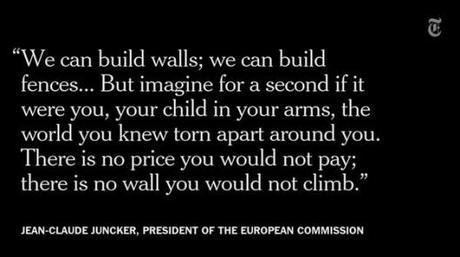
It came to my mind yesterday that most of us have limited knowledge of the refugee situation in the United States alone, much less the world. The purpose of this post is to give a few important facts about refugees and resettlement. Because I am in the United States, I have focused on the process here. In order to better understand the worldwide problem, I think it’s important to know what your countries rules and laws are.
Legal Definition: “A refugee, as defined by Section 101(a)42 of the Immigration and Nationality Act (INA), is a person who is unable or unwilling to return to his or her home country because of a “well-founded fear of persecution” due to race, membership in a particular social group, political opinion, religion, or national origin.
Brief History: The definition of the word comes from the United Nations 1951 Convention and 1967 Protocols. The definition was crafted because of the need for international protection of displaced peoples after World War II. Policies around refugee resettlement in the United States go back to 1980, when Congress passed the Refugee Act and huge numbers of Souteast Asians came to the United States under refugee status. It was then that the Office of Refugee Resettlement (ORR) was created.
Key Point: Our refugee policies have not been truly updated since that time!
Process: The process is long and difficult, and the number of refugees who end up with legal citizenship in a country where they resettle is small compared to the overall number of refugees. Each year, the president submits a report to Congress called the “Proposed Refugee Admissions Report.” The overall number of refugees that the U.S will accept is proposed by the president and agreed on (or not) by congress. It’s important to note that the number of refugees actually settled is generally far fewer than the number agreed on. This is because of the cumbersome and ridiculously large amount of paperwork that goes into each person’s application. In 2014, that number was 70,000 but the actual number was around 45,000.
There are three choices for a refugee once they escape: repatriation (once safe), local integration, resettlement in a third country.
Priority for resettlement is based on three things:
- Priority 1: Individual cases primarily based on persecution
- Priority 2: Key designated groups – these are selected in consultation with other groups like UNHCR.
- Priority 3: Relatives of refugees who are already settled in the U.S. (spouses, parents, children under 21)
The process begins in camps or at borders by UNHCR. UNHCR registers refugees and determines their status. They then refer to the US Resettlement Program (USRP). Prescreening is done by Resettlement Support Center staff, followed by an onsite interview by United States Citizenship and Immigration Service and Department of Homeland Security. It is safe to say that with the increased threats and fear of terrorism, this part is grueling. Once the person is approved, they are finger printed and have security checks.
Key Point: The average time in a refugee camp has risen to 17 years.
Final steps before arrival are medical screening and determining where in the United States the person will be resettled. Travel arrangements are then made by the International Organization on Migration.
Key Point: Cost of travel must be repaid within 6 months of arrival in the United States. It is not free. There is no free lunch in this process. I promise.
On Arrival: A VOLAG (Volunatry Agency) meets the refugee on arrival and takes them to predesignated, furnished housing. During the first 90 days, VOLAGS arrange for housing, food, transportation, medical care, and employment counseling services. Each state has a state coordinator and the VOLAGS work closely with the state coordinators. Both ultimately answer to the Office of Refugee Resettlement.
Key Point: The goal of the United States Refugee Program is “Self-sufficiency after 8 months.”
Think about that for a minute. You’ve lost everything. You hear a car backfire and you think it’s a bomb. Anyone in authority fills you with fear, because you know your life journey is literally in their hands. You grieve for the family you left behind, even as you are relieved that you are finally safe. But in eight months, you need to be a fully functioning member of society. That is an enormous task.
Difference between Immigrants, Refugees, and Asylees: An immigrant comes to the country of their own accord. Some would argue that often circumstances in their countries are so difficult that they have to look at other options, but they are not forced from their homes. Refugees and asylees must have a “well-founded fear of persecution due to race, religion, nationality, political opinion, or membership in a particular social group.”* The difference is that refugees get permission to come to a country before they arrive, whereas asylees receive permission after they arrive.
Important things to remember: Research has shown there to be four main categories of stress experienced by refugees. These are Traumatic Stress, Resettlement Stress, Acculturation Stress, and Isolation Stress. A key part of working through this is strengthening areas that contribute to resilience in people. Among other things, family and community support for the refugee contributes to resilience and ability to move forward. Community matters. Family matters.
As I think about the current crisis, I think the photograph at the top says it all, so in closing, I will repeat it: “….But imagine for a second if it were you; your child in your arms; the world you knew torn apart around you. There is no price you would not pay; There is no wall you would not climb.”**
I highly recommend the film The Good Lie. The movie came out last year, but was not widely shown. It tells the story of the Lost Boys and Girls of Sudan, orphans who walked thousands of miles to get to refugee camps in Kenya. It is a poignant look at the refugee journey and the tenacity it takes to resettle. I’ve included the trailer for the movie here.
Resources:
- A Refugee Camp in the City.
- Beyond the Fire: Teen Experiences in War.
- Refugee Arrival Data
- Refugee Council USA
- Refugee Fact Sheet
- Refugee Myths and Realities
*[Source] http://www.brycs.org/aboutRefugees/refugee101.cfm
**Jean-Claude Juncker, President of the European Commission

